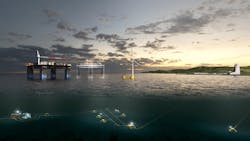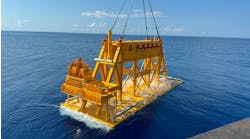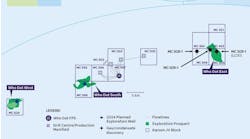As the offshore industry embraces the “energy transition,” operators and developers are looking for ways to capture carbon and store it offshore in man-made subsea storage facilities. European operators, equipment manufacturers and service companies are leading the way in this arena, with projects being developed and planned offshore Norway, the UK and The Netherlands.
One key example is the Net Zero Teesside project, previously known as the Clean Gas project, initiated by OGCI Climate Investments. Earlier this year, five major oil companies formed a consortium to accelerate this carbon-capture project in northeast England. The consortium includes BP (as operator), Eni, Equinor, Shell, and Total.
The program involves constructing a transportation and storage system to gather industrial carbon dioxide (CO2), compress it and store it safely in a reservoir beneath the North Sea.
This new infrastructure, the consortium hopes, will encourage new investment in the region from industries that wish to store or use CO2.
In addition, a combined cycle gas turbine facility with carbon capture technology will provide low carbon power to complement renewable energy sources.
The project aims to capture up to 6 MM metric tons/yr (6.61 MM tons) of CO2 emissions, equivalent to the annual energy consumption of 2 million homes in the UK. It should also deliver up to £450 million ($576 million) annually to the economy of the Teesside region and support up to 5,500 jobs.
Net Zero Teesside has signed memoranda of understanding with three existing industrial partners.
Still another example can be seen in the Northern Lights project. In May, Equinor, Shell, and Total decided to invest in the project, which is part of Norway’s first exploitation license for CO2 storage on the Norwegian continental shelf.
Plans for development and operation have been handed over to the Ministry of Petroleum and Energy. The investment decision is subject to final investment decision by Norwegian authorities and approval from the EFTA Surveillance Authority.
The investment decision concludes the study phase during which the partners worked closely with Norwegian authorities to conduct engineering studies and project planning, drill a confirmation well, and develop the necessary agreements. The partners say they intend to establish a joint venture company.
Initial investments are estimated at NOK 6.9 billion ($673 million), with about 57% of the investment going to Norwegian contractors.
The project will be developed in phases. Phase 1 includes capacity to transport, inject, and store up to 1.5 MM metric tons of CO2 per year. Once the CO2 is captured onshore, it will be transported by ships, injected and permanently stored some 2,500 m (8,202 ft) below the seabed in the North Sea.
The CO2 receiving terminal will be at the premises of Naturgassparken industrial area in the municipality of Øygarden in western Norway. The plant will be remotely operated from Equinor’s facilities at the Sture terminal in Øygarden and the subsea facilities from Oseberg A platform in the North Sea.
The facility will allow for further phases to expand capacity. Investments in subsequent phases will be triggered by market demand from large CO2 emitters across Europe, Equinor said.
If the project receives a positive final investment decision from the Norwegian government in 2020, Phase 1 is expected to be operational in 2024.
Equinor, on behalf of the partners, has signed non-binding memoranda of understanding with several European companies for the development of value chains in carbon capture and storage. Binding commercial agreements will depend on positive investment decisions from Norwegian authorities and for individual third-party projects.
This cross-industry collaboration enables handling of large CO2 volumes that would otherwise have been emitted, Equinor claims. This new value chain and infrastructure for carbon capture and storage projects can only be developed with cooperation between governments and companies.
Service sector adaption
The service industry is also adapting to serving this emerging offshore market. Last fall, Aker Solutions said it was looking for renewable and low carbon solutions to provide around half its revenue by 2030. A key part of this re-alignment will be an orientation toward service of the emerging carbon will offer technologies for carbon capture, utilization and storage (CCUS).
Although the oil and gas industry will likely remain its biggest market, the company said it would be aiming for a more balanced portfolio of products and technologies, in line with global trends. The company says that it expects demand for oil and gas to keep rising over the next decade, although not as fast as for renewable energy.
Aker Solutions says that it has been growing its CCUS capability since delivering the Sleipner storage solution in the Norwegian North Sea in 1996, and is presently contributing its subsea experience to the Northern Lights CO2 storage project in the same sector.
In 2015, the company delivered the world’s first subsea gas compression system to Equinor’s Åsgard field in the Norwegian Sea, and it is working on the first subsea gas compression project offshore Western Australia for Chevron’s Jansz-Io field.
The company is moving forward with applications of its carbon capture technology at industrial locations in Norway and Sweden. In April, DNV GL approved Aker Solutions’ carbon capture technology for a full-scale demonstration project in Norway. The project is designed to remove carbon emissions at a cement plant. Gassnova, the Norwegian state’s agency for implementation of carbon capture and storage projects, initiated the project at Norcem’s cement plant in Brevik, Norway.
The Norcem Brevik carbon capture plant forms part of Europe’s first industrial demonstration of CO2 capture, transport and storage. The captured CO2 is to be transported and injected into a CO2 storage site offshore Norway, developed by the Equinor-headed Northern Lights consortium.
Meanwhile, MAN Energy Solutions has won a contract to supply three RG compressor trains for a carbon capture, utilization and storage project offshore the Netherlands.
The Port of Rotterdam Authority, Energie Beheer Nederland (EBN) and N.V. Nederlandse Gasunie are jointly developing the ‘Porthos’ (Port of Rotterdam CO2 Transport Hub and Offshore Storage) project, which will involve transporting and storing around 2.5 MM t/yr of CO2 (carbon dioxide) beneath the North Sea.
The CO2 will be captured by various companies in the Rotterdam port area, a region said to account for more than 16% of the Netherlands’ carbon-dioxide emissions.
At the end of last year, the Porthos group signed agreements with various companies interested in reducing their environmental footprints by capturing their CO2 emissions and feeding them into the Porthos pipeline.
The line will run for around 30-33 km (18.6-20.5 mi) through the Rotterdam port area, with the CO2 then transported to a platform 20 km (12.4 mi) offshore for pumping into the depleted P18 gas fields (which are expected to have a storage capacity of ~37 MM t of CO2.)
MAN’s scope covers engineering of two RG 25-4 and one RG 31-4 type compressor trains with an order for three further units likely to follow at a later stage.
The compressor trains will be at a compressor station on Maasvlakte, the man-made, western extension to Europoort, where the CO2 will be pressurized to ~132 bar (1,914 psi) in order to transport and inject the gas into the fields which are 3,200-3,500 m (10,498-11,483 ft) beneath the North Sea.
The compressors will be able to handle up to 285 t/hr of CO2 per hour, depending on how many units are running.
Porthos is set to store the first CO2 under the North Sea by the end of 2023, with MAN’s engineering contract likely to be finalized this summer.





